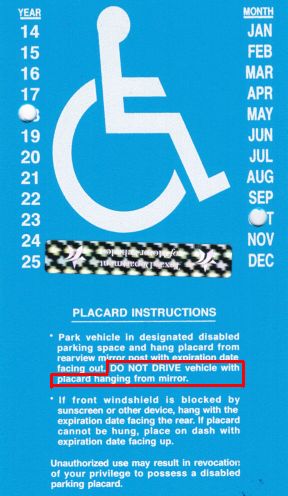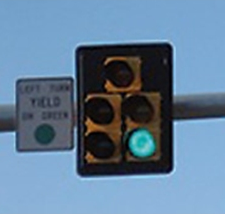DRIVING TIP #4: Don’t drive with your disabled placard on your mirror
 How often do you see someone driving around with the big, blue (or sometimes red) disabled parking placard hanging from their rearview mirror? If you’re like me, probably all the time.
How often do you see someone driving around with the big, blue (or sometimes red) disabled parking placard hanging from their rearview mirror? If you’re like me, probably all the time.
If you’re one of those people doing that, then you’re doing it wrong.
Besides the fact that it explicitly says “DO NOT DRIVE vehicle with placard hanging from mirror” in the instructions on the back of the permit (yes, you’re supposed to take the time to read those words there), and although it’s not specifically illegal, it should be common sense that leaving something that big on your mirror while driving blocks a non-trivial portion of your field of vision, an inherently dangerous proposition. Admittedly, it’s maybe 10% or so of your view, but something could be in that area that makes all the difference, so why take that chance? It only takes a couple of seconds to take it down from your mirror before driving and put it back up there when you park in a reserved spot.
Automobiles Laws and policies Safety: Driving tips
by Brian
Comments Off on DRIVING TIP #3: Wait in the intersection to turn left
DRIVING TIP #3: Wait in the intersection to turn left
 In my previous tip, I discussed not blocking intersections. Today, I’ll discuss a time when it’s okay to wait in the intersection.
In my previous tip, I discussed not blocking intersections. Today, I’ll discuss a time when it’s okay to wait in the intersection.
Sometimes you’ll come to an intersection where you want to turn left and there’s a flashing yellow arrow or a circular green signal but no green arrow at the time you want to turn. In this situation, I usually see people dutifully wait behind the stop line. Then the light turns red and they’re still sitting there. Even worse are intersections that don’t have a protected left arrow at all– I’ve seen people wait behind the line through multiple cycles because oncoming traffic is too heavy to allow them to turn. Occasionally they’ll even give up.
Instead of waiting behind the line, the best thing to do if you need to wait to turn left is to move part of the way into the intersection and wait there. Then, if the light turns red before you’re able to turn, the oncoming traffic will stop and you can complete your turn.
Automobiles Laws and policies Safety: Driving tips
by Brian
Comments Off on DRIVING TIP #2: Don’t block the box!
DRIVING TIP #2: Don’t block the box!
 This week, San Antonio police began targeted enforcement of the state’s law against stopping in an intersection. The stepped-up enforcement is part of a pilot project called “don’t block the box”, where the “box” is the intersection and adjacent crosswalks. The program is modeled on similar programs in other cities. Ten problematic intersections all over San Antonio are part of this pilot project and have had signs like the one shown here installed. (Understand, though, that the law applies to all intersections, not just those marked with signs.) This is a statewide problem, so keep reading even if you’re not in San Antonio.
This week, San Antonio police began targeted enforcement of the state’s law against stopping in an intersection. The stepped-up enforcement is part of a pilot project called “don’t block the box”, where the “box” is the intersection and adjacent crosswalks. The program is modeled on similar programs in other cities. Ten problematic intersections all over San Antonio are part of this pilot project and have had signs like the one shown here installed. (Understand, though, that the law applies to all intersections, not just those marked with signs.) This is a statewide problem, so keep reading even if you’re not in San Antonio.
Automobiles Laws and policies Safety: Driving tips
by Brian
Comments Off on DRIVING TIP #1: Scan the road
DRIVING TIP #1: Scan the road
For this first bite-sized driving tip, I’m picking a topic that’s not even discussed on my Texas traffic laws page— scan the road.
Driving down the right lane of a major street recently, I crested the top of a hill and immediately saw a stalled truck in my lane nearly a mile down the road. Traffic in both lanes was light enough to easily change lanes, so I moved to the left lane as soon as I saw the hazard. There were two other cars traveling in the right lane ahead of me and BOTH of them continued down the lane until they were nearly on top of the broken-down truck. At that point, they had to hit their brakes and make a sudden lane change to avoid hitting it.
“WTF? Are these people blind?”
Automobiles Laws and policies Safety: Driving tips
by Brian
Comments Off on Driving tips coming soon
Driving tips coming soon
The top-viewed page on my website texashighwayman.com is consistently the page on Texas traffic laws. It’s obviously a topic lots of folks are interested in. And from what I’ve seen on the roads, lots more folks need to look at it. 🙂
While that page was initially intended to highlight common questions folks have, it’s become quite comprehensive over the years. If you take the time to read the whole thing, it’ll take you while and you’ll feel like you’ve been drinking from a fire hose. So, I’ve decided to parcel-out some of the topics from that page in smaller doses here over the next few months, along with some additional tips that aren’t covered on that other page.
If you’re interested, I’ll announce postings on my Twitter and Facebook pages or just check back here periodically.
Until then, drive safely!
more »
Automobiles Commuting Data visualizations Travel
by Patrick
Comments Off on Where to find alternative fuel stations in Texas
Where to find alternative fuel stations in Texas
If you’re going to invest in an alternative-fuel vehicle, you might want to check where you can fill up. The city you’re in makes a difference.
For those relying on biodiesel, you’re good to go in Austin and not so bad in San Antonio, recent data from DriveBiodiesel.net shows.
Dallas has a broad mix of E85 and natural gas pumps, according to E85Locator.net and CNGLocator.net. Houston has a decent spread of E85 stations.
West Texas? One station, in Midland. Natural gas.
One thing’s for sure, if you want to take a road trip in an alternative-fuel vehicle, plan well. Some places will leave you with fumes.
Texas road-rage accidents dashboard
When are drivers likely to lose their cool, to the point of rage?
I figured the hours after bars closed on weekends were the hot times. But that’s not true, according to a state road-rage database obtained by the Express-News.
I put together an online dashboard to query the database, which is hosted as a Google Fusion Table. It’s a great way to get a quick snapshot of layered filters, such as age, gender, ethnicity, days, times, etc.
Try it out below. For convenient side-by-side comparisons, click the “Compare Two Views” button under the dashboard.
I gleaned a few interesting insights myself.
Automobiles Commuting Data visualizations Oil and gas prices Travel
by Patrick
Comments Off on Record high gas prices changing how Americans drive
Record high gas prices changing how Americans drive
With wild swings in gas prices pushing ever higher, U.S. drivers are slowly curbing their habits.
Regular-grade gas averaged more than $3.60 a gallon nationwide in 2011 and 2012. It’s never been so high, even when adjusted for inflation. The last records were set during the Iran hostage crisis three decades ago.
High prices, along with recessions, have tugged at America’s driving addiction, bringing down mileage in 1979 and again in recent years. But unlike gas prices, which can arc 40 percent in a year, driving habits die hard.
The difference jumps out when you juxtapose the data in a graphic. Mashing data like this can sometimes be confusing when you have two separate axes, but I think there’s an interesting pattern here.
Paying too much for car insurance?
If you’re in Texas, odds are you’re paying more for car insurance than the average U.S. driver, says a survey by Insure.com.
I ran the survey’s data through Google Fusion Tables to see a bigger picture, and it turns out costs are as varied as the nation’s landscape itself. In particular, extreme highs touch all three coasts as well as the Canadian and Mexican borders.
Hover over states to see average costs. The darker the shade, the higher the cost.
Reasons for the undulating costs are, literally, all over the map, from claim-happy and disaster-prone Louisiana and bumper-to-bumper traffic in Georgia, to slow-poke drivers in Iowa and strict teen-driving laws in Maine, according to Insure.com.
The survey looked at 2013 cars and settled on a typical guy with a clean record and good credit. Texas rolled in at $1,545, ranking 19th overall.
Texas joined 19 other states and D.C. to rank higher than the $1,510 national average. Louisiana tops the list with $2,699. Maine sits at the bottom with $934.
Here are the top 10. Again, use hover to see dollars. The full table’s here.
Automobiles Commuting Data visualizations
by Patrick
Comments Off on Worst commutes in San Antonio
Worst commutes in San Antonio
San Antonio commuters spend an average of 23 and a half minutes getting to work, the latest federal data show.
Nothing shattering. In fact, it’s about two minutes less than the national average.
But what surprises me are some of the zip codes with the longest commutes.
Before seeing the U.S. Census data mapped out recently by a team at WNYC in New York, I figured commuters with the longest slogs tended to live in areas swaddling Loop 1604 on the North Side and exurbs like Boerne and New Braunfels.
In the map above, the beleaguered U.S. 281 corridor shows up as expected. But South Loop 1604 looks worse than its northern leg. And look at the bruised ring of satellites to the west and south.
A concentration of jobs on the North Side, along Loop 1604 and interstates 35 and 10, is likely sucking in many of these commuters from counties on all sides. The pull is stronger and wider than than I had realized.
You can hover over zip codes to see average commute times. You can also slide the map to see other cities, and zoom out to see other states. Here’s a full-page version.
Note that these stats include transit, walking and bicycling. But in a car town like San Antonio, despite volatile gas prices the past five years, nine out of 10 people still drive or carpool to work. Here’s a breakdown.